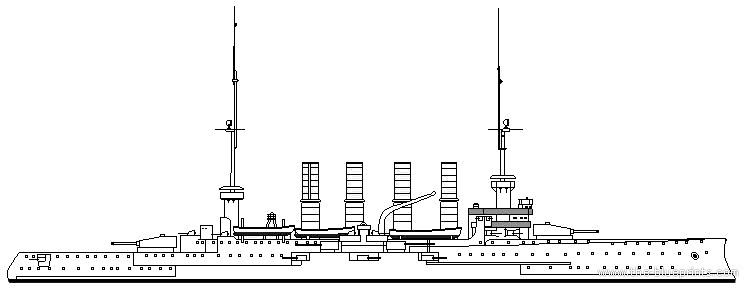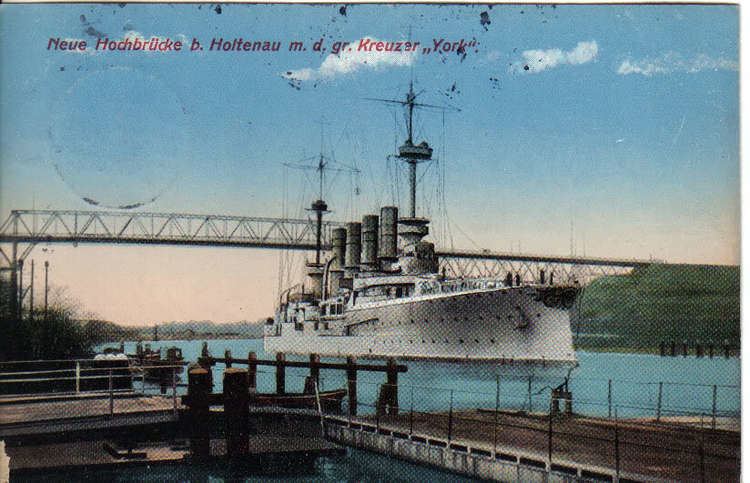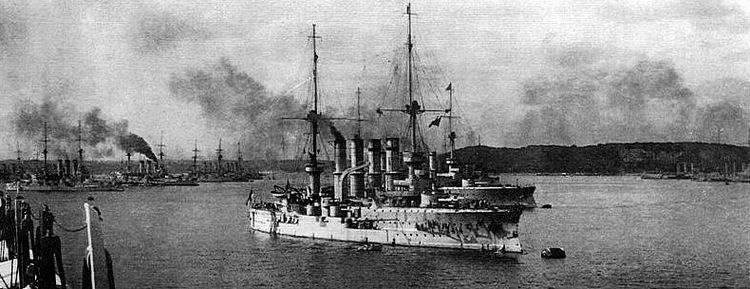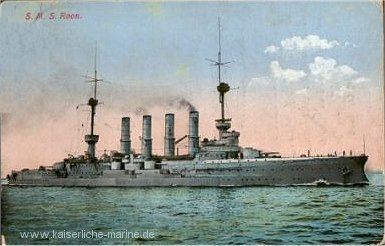Name Roon Laid down August 1902 Decommissioned 1911 Length 126 m Launched 27 June 1903 | Commissioned 5 April 1906 Commissioned 1914 Construction started August 1902 Draft 7.43 m | |
 | ||
SMS Roon was the lead ship of her class of armored cruisers of the Imperial German Navy. The ship was authorized under the second Naval Law in 1902, and built at the Imperial Dockyard in Kiel at the cost of 15.3 million marks. The ship was named after Albrecht von Roon, a Prussian general and politician. She displaced up to 9,875 metric tons (9,719 long tons; 10,885 short tons) and was armed with a main battery of four 21 cm (8.3 in) guns. Her top speed was 20.4 knots (37.8 km/h; 23.5 mph).
Contents
- Construction
- Service history
- Bombardment of Scarborough Hartlepool and Whitby
- Operations in the Baltic
- Later service
- References

The ship participated in several actions during the First World War, including the raid on Scarborough, Hartlepool and Whitby, where she acted as a scout for the High Seas Fleet. Roon also saw duty in the Baltic Sea, including a battle in July 1915 against Russian cruisers and shore bombardment missions. After 1916, Roon was used as a training and barracks ship in Kiel until the end of the war. It was intended to convert the ship into a seaplane tender, but the plan was eventually abandoned. The ship was struck from the naval register in 1920 and scrapped thereafter.

Construction

Roon was ordered under the provisional name Ersatz Kaiser and built at the Imperial Dockyard in Kiel under construction number 28. Her keel was laid in 1902 and she was launched on 27 June 1903. Fitting-out work was lengthy, but was completed by 5 April 1906, being commissioned into the Imperial German Navy the same day. She had cost the Imperial German Government 15,345,000 Goldmarks.

Roon displaced 9,087 t (8,943 long tons; 10,017 short tons) as built and 9,875 t (9,719 long tons; 10,885 short tons) fully loaded, with a length of 126.50 m (415 ft), a beam of 19.60 m (64 ft 4 in) and a draft of 7.43 m (24 ft 5 in) forward. She was powered by three vertical triple expansion engines, which developed a total of 17,272 indicated horsepower (12,880 kW) and yielded a maximum speed of 20.4 knots (37.8 km/h; 23.5 mph) on trials. She carried up to 1,630 t (1,600 long tons; 1,800 short tons) of coal, which enabled a maximum range of up to 5,080 nautical miles (9,410 km; 5,850 mi) at a cruising speed of 12 knots (22 km/h; 14 mph).

She was armed with four 21 cm (8.3 in) guns arranged in two twin gun turrets, one on either end of the superstructure. Her secondary armament consisted of ten 15 cm (5.9 in) guns, fourteen 8.8 cm (3.5 in) guns and four 45 cm (18 in) underwater torpedo tubes, one in the bow, one in the stern, and one on both beams.
Service history
Roon was laid down in August 1902 at the Kiel dockyard, and launched in June 1903, during which the inspector general Alfred von Waldersee was made patron of the ship. The ship was completed in April 1906, at a cost of 15,345,000 Marks. In April 1907, Roon and the light cruiser Bremen sailed to the United States to participate in the Jamestown Exposition commemorating the anniversary of the arrival of colonists in Chesapeake Bay on 26 April. In addition to the German delegation, the international fleet consisted of warships from Great Britain, Japan, Austria-Hungary, France, Italy, and several other nations.
In 1908, Roon was serving as the flagship for Rear Admiral Jacobsen, in the Second Group of the Scouting Division of the High Seas Fleet, along with her sister ship Yorck. After being replaced as the flagship of the Scouting Group on 30 September by the new battlecruiser Moltke, Roon was decommissioned in 1911; however, she was recommissioned three years later at the outbreak of World War I. At the start of hostilities, Roon was serving as the flagship of the III Scouting Group. On 3 November 1914, she participated in the operation to bombard Yarmouth.
Bombardment of Scarborough, Hartlepool and Whitby
A month later, on 15–16 December, she participated in the bombardment of Scarborough, Hartlepool and Whitby. Along with the armored cruiser Prinz Heinrich, Roon was assigned to the van of the High Seas Fleet, which was providing distant cover to Rear Admiral Franz von Hipper's battlecruisers while they were conducting the bombardment. During the operation, Roon and her attached destroyers encountered the British screening forces; at 06:16, Roon came in contact with HMS Lynx and Unity, but no gunfire was exchanged and the ships turned away. Following reports of British destroyers from Roon as well as from Hamburg, Admiral von Ingenohl ordered the High Seas Fleet to turn to port and head for Germany. At this point, Roon and her destroyers became the rearguard for the High Seas Fleet.
At 06:59, Roon, by this time joined by the light cruisers Stuttgart and Hamburg, encountered Commander Jones' destroyers. Jones shadowed Roon until 07:40, at which point Stuttgart and Hamburg were detached to sink their pursuers. At 08:02, Roon signaled the two light cruisers and ordered them to abandon the pursuit and retreat along with the rest of the High Seas Fleet. At 07:55, Beatty received word of Roon's location, and in an attempt to intercept the German cruisers, detached HMS New Zealand to hunt the German ships down, while his other three battlecruisers followed from a distance. By 09:00, Beatty had become aware that the German battlecruisers were shelling Hartlepool, so he decided to break off the pursuit of Roon and turn towards the German battlecruisers.
Operations in the Baltic
Admiral Reinhard Scheer decided that because Roon and the other armored cruisers of the III Scouting Group were slow and lacked thick enough armor, they were unsuitable for service in the North Sea. Therefore, after April 1915, she operated in the Baltic Sea, participating in several bombardment missions. On 11 May, the British submarine E9 spotted Roon and several other ships en route to Libau, which had been recently captured by the German army. E9 fired five torpedoes at the German flotilla; two passed closely astern of Roon while the other three missed their targets as well.
On 2 July 1915, Roon participated in a battle with Russian cruisers off the shores of Gotland, Sweden. The light cruiser Augsburg and three destroyers were escorting the minelaying cruiser SMS Albatross when they were attacked by four Russian cruisers—the armored cruisers Bayan, Admiral Makarov, and light cruisers Bogatyr and Oleg. Augsburg escaped while the destroyers covered the retreat of the Albatross, which was severely damaged and forced to seek refuge in neutral Swedish waters. Roon and the light cruiser Lübeck sortied to relieve the beleaguered German destroyers. Upon arriving at the scene, Roon engaged Bayan, and Lübeck opened fire on Oleg. Shortly thereafter, the Russian cruiser Rurik, along with a destroyer, arrived to reinforce the Russian flotilla. In the following artillery duel, Roon was hit several times, and the German ships were forced to retreat.
On 10 August, Roon and Prinz Heinrich shelled Russian positions at Zerel on the Sworbe Peninsula. There were several Russian destroyers anchored off Zerel; the German cruisers caught them by surprise and damaged one of them.
Later service
The fog of war led to several instances where the Royal Navy misidentified several vessels as Roon in 1916. On 16 February 1916, Roon was mistakenly reported as having been captured by a British cruiser in the North Atlantic. The ship was also mistakenly reported to have taken part in the Battle of Jutland as the flagship of the screening force for the main body of the High Seas Fleet. This mistake appeared in historical works published shortly after the First World War, but later works have corrected it.
In November 1916, Roon was disarmed and converted into a training and accommodation ship. Stationed at Kiel, she served in this capacity until 1918. The German Navy had previously experimented with seaplane carriers, including the conversion of the old light cruiser Stuttgart early in 1918 for service with the fleet. Stuttgart could carry only two aircraft, however, which was deemed insufficient for fleet support. As a result, plans were drawn up to convert Roon into a seaplane carrier, with a capacity for four aircraft. The ship's main battery would have been removed and replaced with only six 15 cm guns and six 8.8 cm anti-aircraft guns; the large hangar for the seaplanes was to have been installed aft of the main superstructure The plan did not come to fruition, primarily because the German Navy relied on zeppelins for aerial reconnaissance, not seaplanes. Roon was struck from the naval register on 25 November 1920 and scrapped the following year, in Kiel-Nordmole.
